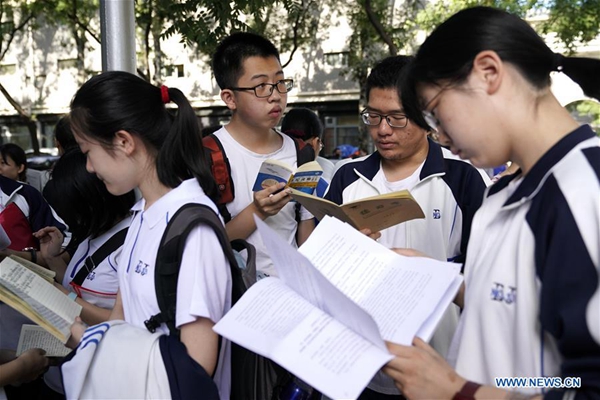Education, the cornerstone to progress: The development of China's education system
- By Wang Yiming
 0 Comment(s)
0 Comment(s) Print
Print E-mail China.org.cn, August 6, 2019
E-mail China.org.cn, August 6, 2019

It was a curious sight. Kneeling at the starting line, each runner held on to a small blackboard. In the race, there was no familiar firing of the starting pistol. The contestants could only begin their sprint after they finished writing certain Chinese characters on their individual blackboards. This strange spectacle, which was called the "literacy race", took place at the first sports event of the Chinese People's Liberation Army on August 2, 1952.
That was one of the campaigns to promote literacy when the People's Republic of China was just founded. It's hard to imagine that the world's second largest economy, whose nine-year compulsory education program now has a 100% penetration rate, used to face a stark illiteracy rate of 80% back in 1949. The past seventy years witnessed China's endeavor to prioritize education and the remarkable achievements that it has made.
1949 – 1978: Recovery and exploration
"The restoration and development of the peoples' education is one of the most important tasks at present", said Mao Zedong, chairman of the newly founded People's Republic of China where the enrollment rate in elementary schools was below 20% and in junior secondary schools, a mere 6%.
The new government was then committed to increasing the literacy rate and establishing new schools, including private, public, and collective institutions, aiming to provide access to education for all. In just three decades, China's illiteracy rate dropped to 22.8%. By 1978, there were nearly 1.2 million primary and secondary schools, 3 times more than in 1949.
In the early 1950's, China mainly followed the Soviet education model, especially for higher education. "Some of the teachers were experts from the Soviet Union", Xie Xiuchen, a 90-year-old retired professor at Beijing Normal University who was recommended for university admission in 1950, recalled.
After the 1960s, the influence of the Soviet paradigm had declined, and China's own socialist education system featuring a balance between Confucian and Western-style education was gradually established.
1978-2019: Reform and development
"Education should be geared towards the need of modernization, of the world, and of the future," Deng Xiaoping proposed, whose far-reaching thoughts charted the direction for education development after China's reform and opening up in 1978. The education system was then restructured to form the system that exists in China today.
The reintroduction of the National College Entrance Exam (NCEE), known as Gaokao, marked not only a major change for millions of ordinary people, but also for the overall progress of Chinese higher education.
Back in 1978, China only had 598 higher education institutions (HEIs), which enrolled 117,000 students. By 2018, the enrollment had jumped to 28.31 million students in 2663 HEIs, which created more skilled workers and professionals for the Chinese economy.
Enormous progress has also been made in basic education. The national plan to make the first nine years of education compulsory and universal was implemented in stages since the promulgation of the Compulsory Education Law of the People's Republic of China in 1986.
Starting in 2007, the state exempted rural students from tuition fees during the nine-year compulsory education period. The policy also included the provision of free books and accommodation subsidies to impoverished students. By the autumn of 2008, free compulsory education was also extended to urban students.
Technology has also been harnessed to narrow the disparity in the quality of education between urban and rural areas. With tens of billions spent in upgrading teaching facilities as well as IT equipment, students in rural areas now enjoy access to learning resources similar in quality to urban students.
Since the importance of technology has grown significantly, the government has recognized the intense competition in this field and placed a great deal of emphasis on it. Changes can be seen in its direction to focus more on Science, Technology, Engineering and Medicine (STEM) content, as well as the methods of delivery, Massive Open Online Courses (MOOCs) and other means of distance-learning.
With the deepening of reform and opening-up, international cooperation and exchanges in China's education system entered a new stage. Each year hundreds of Chinese students go abroad for studies or research, in 2018, that number reached 662,100.
At the same time, students from around the world have increasingly been drawn to China to enroll in all kinds of courses and attain professional degrees. In 2018, 492,185 students from 196 countries and regions applied to study in Chinese institutions. Scholarly exchanges in many fields have also grown immensely.
Post 2019: Ready for the future
Education is the cornerstone of social progress.From Confucius' time to present day, China always puts education on the list of priorities. Now, new reform pathways are charted by Chinese leaders to make education better aligned with the needs of the people.
Two implementation plans, the Education Modernization 2035 Plan and the detailed 2018-2022 Plan, were released by the Central Committee of the Communist Party of China (CPC) and the State Council on February 23, 2019.
The plans set the direction and objectives for the creation of a modern education system in China with universal and high quality compulsory education, competitive world-class higher education institutes, as well as enhanced vocational education, so that the education system can better serve society.
Though achieving enormous progress over the past 70 years, as a country with a huge population and large regional disparities, China still has a long way to go before its education system can fully meet the demands of its economic and cultural development. But judging from its past success, there are ample reasons to expect that it will get there.






Go to Forum >>0 Comment(s)